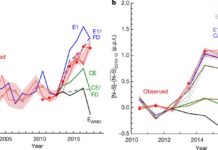What will the University of Waterloo campus look like by 2025? Students in PLAN 211 are using the AI program DALL-E 2 to create futuristic and sustainable visualizations to answer this question.
PLAN 211: Design Studio Foundations is a course taught by Dr. Katherine Perrott. The course has partnered with the Sustainability Office to explore what the UW campus could look like in the future, keeping the university’s sustainability goals at the forefront.
DALL-E 2 is an artificial intelligence (AI) system that was created by the same developer as ChatGPT. DALL-E 2 can design whole images based on written prompts. It recreates art and photos in various artistic styles or can create new designs. As it is a new platform there is still more to learn about the potential of the platform and possibilities for creation.
“We started [using] DALL-E 2 as a way to envision sustainable campuses. Through envisioning what it [campus] will look like through an AI you have the ability to see spatial imaginaries,” said Katie Traynor, a 2B planning student. “Spatial imaginaries are a way of envisioning different perceptions of reality. When we think of sustainability sometimes we think of eco-friendly, green infrastructure, people walking or cycling instead of taking vehicles. Through this project we wanted to encapsulate the idea of possibly making changes and renovations to the University of Waterloo.”
For this project, students started with an initial command for DALL-E 2 that included components of a sustainable campus. Then they added commands until the image generated by the AI resembled their sustainable vision. The image created was turned into a poster.
Traynor’s project, ‘Techno Utopia,’ was based on the objective of a “sustainable future within a university campus” and Danish architect Jan Gehl’s words, “Life, space, buildings — in that order.”
Green is a prominent color in Traynor’s poster as the AI has interpreted “lush vegetation” and created trees and green space. A water feature is also present. People sitting in these outdoors spaces and biking along the path show how spaces could be reinvisioned and used on campus. The Sustainability Office released a draft of the Sustainable Landcare Standard in fall 2022. Part of this standard is biodiversity. Looking at the posters created using DALL-E 2 there is a variety of different green space designs. When approaching changes to campus with a sustainable mindset, understanding the diversity of species on campus is important in developing strategies to protect them while transforming our campus landscape.
After using DALL-E 2 to generate an image, students reflected on their idea of a sustainable campus and their stance on the future of AI in urban design.
“I believe AI has a big role to play in the future of urban design. It can be super helpful in developing ideas and making concepts, as it has the entire internet’s worth of precedents to draw from. It is nowhere close to rendering human urban designers obsolete, at least in its current form, but it can certainly be a very useful tool for planners.” said Khalil Heron, a 2B planning student.
Heron’s project ‘The Future of Our Urban Street Scapes’ was inspired by the objective of creating an “attainable sustainable future for our cities.”
Their poster stands out, vibrant red and orange colors used to compose the scene of a city street. The train, a focal point of the image, is reminiscent of the TTC, or the local ION. People biking and walking are also seen. These forms of transportation coexist to communicate the idea of people-centric streets. This concept can be applied to the future of campus, by reviewing the accessibility of biking and walking infrastructure.
All 30 student posters are on display in EV3. Looking at each unique concept and image created offers a variety of opportunities for sustainability, future campus design, how nature can be integrated with buildings and the continued use of AI.
The projects are on display for the next two weeks in the studio gallery, located in the corridor beside the Design Studio (EV3 2402). Interested students can visit the second floor of EV3 to see more future possibilities for a sustainable campus.





























